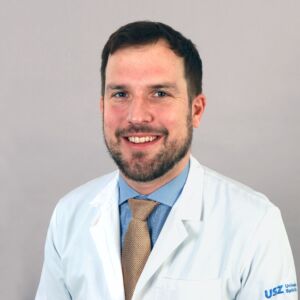Surgical treatment of benign changes to the larynx
Benign changes can occur in the larynx as a result of mechanical or chemical stress. The larynx can also be affected by autoimmune diseases or systemic diseases with scarring changes. These usually manifest themselves as a foreign body sensation, hoarseness or difficulty swallowing. The clarification of benign changes in the larynx includes a precise survey of the patient’s history to identify possible triggers and an endoscopy of the larynx. If a malignant disease cannot be ruled out, surgical removal under anesthesia is necessary. This operation is performed through the mouth, often using a laser. In the case of benign changes, our colleagues in phoniatrics will determine the next treatment steps.
Treatment of malignant laryngeal tumors
Malignant laryngeal tumors are diagnosed in the same way as benign changes in the larynx. Registration for an assessment is possible via a referral to the “Intake consultation”. In addition to an endoscopy with extraction of tissue samples, an examination of the cervical lymph nodes with ultrasound and tomographic imaging (CT or MRI) is also carried out.
The most common risk factor for the development of throat cancer is smoking. For treatment to be successful, smoking should be stopped if possible, for which patients can also be referred to the stop smoking consultation. In addition, swallowing is evaluated by the speech therapist and the patient’s nutritional status (nutritional advice).
Treatment is discussed at the interdisciplinary head and neck tumor board and tailored to the patient. Depending on the type of tumor and its extent, surgical treatment or radiotherapy or combined therapy is recommended. Early stages can be treated by preserving the larynx. Removal of the larynx is necessary in the case of extensive tumors. After completing treatment for a malignant tumor, patients are followed up at our clinic for a period of at least 5 years in the interdisciplinary tumor consultation hours.
Creation or closure of a tracheotomy (tracheotomy)
A tracheotomy can be performed to secure the airway in the event of a serious injury or illness with narrowing of the airway or if ventilation is required for a longer period of time. During a tracheotomy, the windpipe (trachea) is opened from the outside and a cannula is inserted, allowing breathing to bypass the constriction. If this is no longer required, the tracheotomy can be reversed.

